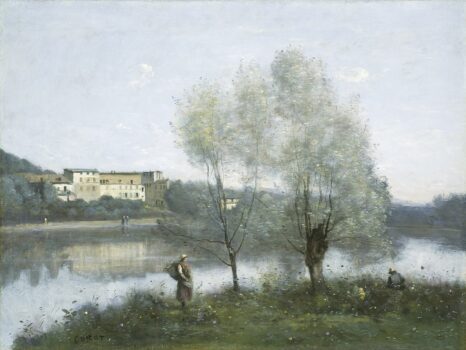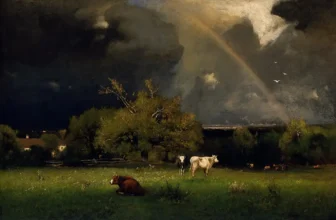Unfolding Tranquility: A Deep Dive into Camille Corot’s “Ville d’Avray”
Shopping Ads: Invest in Hidden Masterpiece: Rare Antique Oil Paintings For Sale. Limited Originals Available 💰😊 Are you looking for authentic hidden masterpiece? Explore old master antique oil paintings from the Renaissance and Baroque eras. From 16th-century portraits to 18th-century landscapes. Authenticity guaranteed, Old Master antique oil paintings for sale. Shop Now! 🎨 Renaissance And Baroque Art Old Master Portrait Paintings Landscape Antique PaintingsWhen one gazes upon Ville d’Avray by Camille Corot, the world seems to pause. There’s no chaos, no urgency, just the subtle murmur of nature, the hum of everyday rural life, and the quiet reverence of the landscape. On the surface, it appears to be a peaceful pastoral scene, a reflection of nature bathed in golden light. Yet, beneath its calm exterior lies a rich tapestry of symbolism, emotion, and personal history. This article ventures deep into the heart of Ville d’Avray, unraveling its layers, decoding its symbolism, and situating it within Corot’s artistic legacy and broader art history.
A Glimpse of the Artist: Camille Corot
Jean-Baptiste-Camille Corot (1796–1875) occupies a fascinating place in the annals of art. Straddling the realms of Neoclassicism and the burgeoning movement of Impressionism, Corot was a transitional figure whose work bridged tradition and modernity. Known for his serene landscapes, Corot mastered the art of blending realism with poetic introspection. Unlike the dramatic romanticism of Delacroix or the grandeur of classical painters, Corot favored a more meditative and lyrical approach.
Ville d’Avray, an unassuming village west of Paris, was more than just a geographical location for Corot. It was his sanctuary, a place steeped in childhood memories and creative inspiration. His family owned a house there, and he returned throughout his life to paint and reflect. The numerous works he created based on this region are not just visual records of a landscape; they are deeply personal expressions of belonging, nostalgia, and quiet reverence.
The Painting: “Ville d’Avray”
Corot painted multiple works titled Ville d’Avray, and while they vary in detail and composition, they share recurring motifs: serene lakes, soft trees, rustic houses, and the ever-present sky rendered in silver and blue. One of the most renowned versions, housed in the Metropolitan Museum of Art in New York, captures the tranquil beauty of a small pond reflecting a cluster of trees and distant houses, a woman standing quietly at the water’s edge. The palette is gentle, muted greens, browns, and dusky blues, and the brushwork is soft, almost tender.
In this painting, nothing seems urgent. There is no grand drama or historical event being illustrated. Instead, Corot invites the viewer into a moment of contemplative stillness. He elevates the ordinary, trees, water, sky, into something sacred and sublime.
What is Happening in “Ville d’Avray”?
At first glance, one might say: nothing much. But therein lies the magic. A figure, often a peasant woman or a washerwoman, appears engaged in a mundane task, perhaps gathering water or simply resting by the lake. She is not the focus in a narrative sense; rather, she blends into the environment, becoming a natural extension of the landscape. Her presence anchors the scene, giving it a human dimension, a touch of lived reality.
The trees curve gently around the composition, forming a natural frame. The reflections in the water echo the scene above, creating a mirror-like sense of harmony. A cottage sits quietly in the background, smoke lazily rising from its chimney. These details whisper of everyday rural life, a rhythm of work, rest, and coexistence with nature.
Symbolism and Interpretation
Though Corot’s paintings often appear simple, they are rich in symbolism, especially for those attuned to the nuances of 19th-century artistic language.
1. The Pond and Reflection
The water in Ville d’Avray acts as both a mirror and a metaphor. Water, in art, frequently symbolizes the subconscious, memory, and emotional depth. Corot’s calm ponds are not mere topographical features, they are emotional mirrors. The way the landscape reflects into the water suggests introspection, memory, and the duality of experience: the outer world and the inner life.
2. The Female Figure
The solitary woman, often interpreted as a washerwoman or peasant, may symbolize simplicity, connection to the land, or even the passing of time. She is not idealized; rather, she embodies a quiet dignity. Her integration into the landscape implies a deep harmony between humanity and nature. She could be seen as an allegorical figure, representing humility, domesticity, or the eternal feminine in art.
3. Trees and Sky
Corot’s trees are never rigid; they bend gently, their forms softened by light. This reflects Corot’s desire not to document but to interpret the world. The trees serve as sentinels of time, growing, changing, shedding leaves, and blossoming again. The sky, often rendered in layers of silvery gray or muted blue, reflects a spiritual dimension. It is open, expansive, and quietly divine.
4. Light and Atmosphere
Corot was a master of atmospheric perspective. His light is not theatrical, like that of Caravaggio or Turner, but soft, immersive. The way light filters through trees, touches the water, and diffuses through mist evokes a sense of timelessness. This subtle handling of light is a precursor to the Impressionists, who revered Corot as a forerunner.
The Artistic Style of “Ville d’Avray”
“Ville d’Avray” belongs to the genre of landscape painting, but it defies strict categorization. It is neither wholly Neoclassical nor Impressionist; instead, it resides in the poetic in-between.
1. Realism with Poetic Sensibility
Corot’s landscapes are grounded in observation. He often painted en plein air, capturing the natural world with careful study. Yet, unlike the Realists who emphasized unvarnished truth, Corot filtered reality through a poetic lens. His landscapes are meditative, emotionally resonant, and often tinged with nostalgia.
2. Pre-Impressionist Techniques
Corot’s influence on the Impressionists is profound. Monet, Pissarro, and Sisley all admired his work. His use of light, loose brushwork, and emphasis on mood over detail prefigured Impressionist techniques. He was among the first to suggest rather than delineate, a tree might be rendered in just a few strokes, yet it breathes with life.
3. Tonal Harmony
Another hallmark of Corot’s style is tonal harmony. He often used a restricted palette, creating a unified and cohesive visual experience. The subtle gradations of color and tone imbue his paintings with a dreamlike serenity, often referred to as “Corot’s silvery light.”
What Is “Ville d’Avray” All About?
At its heart, Ville d’Avray is about memory, tranquility, and the sacredness of nature. It’s a love letter to a place that nurtured the artist’s soul. In an era marked by rapid industrialization, Corot’s painting serves as a quiet resistance, a return to nature, to the cyclical rhythms of the earth.
But more than that, Ville d’Avray is about presence. The painting invites the viewer to slow down, to look closely, to find beauty in stillness. It doesn’t shout or demand; it whispers. It doesn’t depict a grand event but elevates the ordinary to the realm of the sublime. In a sense, it is a visual haiku, simple in form, profound in emotion.
Corot’s Ville d’Avray paintings left an indelible mark on generations of artists. The Impressionists revered him not only for his technique but also for his philosophy: that art should be an expression of feeling, not just form.
Corot’s insistence on painting directly from nature, his exploration of atmosphere, and his lyrical approach paved the way for modern landscape painting. Even today, one can trace echoes of his work in contemporary artists who explore nature not merely as subject but as emotion and metaphor.
Where Is Ville d’Avray Painting Located Today?
There are several versions of Ville d’Avray, each slightly different in composition but united in theme and tone. These works are dispersed among major museums and private collections. Notably:
The Metropolitan Museum of Art (New York) holds one of the most iconic versions. This piece embodies the classic Ville d’Avray composition, soft trees, reflective water, and a solitary figure.
The Louvre Museum (Paris) also has notable works by Corot from this series.
The National Gallery (London) and Musée d’Orsay (Paris) feature other works from Corot’s Ville d’Avray period or similar stylistic landscapes.
Private collections occasionally hold lesser-known or smaller versions, sometimes coming to light in art auctions or retrospectives.
Corot painted the area many times, and each version reveals new layers of his emotional and artistic engagement with the place. So while there is no single “definitive” Ville d’Avray, the body of work collectively forms a deeply personal visual diary.
The Poetry of Place
Camille Corot’s Ville d’Avray is more than a landscape. It is a meditation on peace, memory, and the eternal dialogue between man and nature. In an age that often prizes spectacle, Corot reminds us of the power of quiet moments. His brush does not dazzle, it soothes. His trees do not tower, they embrace. His light does not blaze, it warms.
In Ville d’Avray, Corot offers us a place to return to, a gentle refuge for the eyes and the soul. It is art not just to be viewed, but to be inhabited. And perhaps that is its truest meaning: to create a space, both real and imagined, where beauty lives in the everyday, and where the heart, like the pond, reflects a deeper truth.




